What is the secondary break in basketball
The secondary break is a basketball offensive strategy as well as the alternative phase of transition offense which includes scoring options near the basket or near the perimeter areas immediately after the defensive team prevents the initial primary fast break action.
When does the secondary break occur
The secondary break occurs when the defensive team successfully sprints back to protect their basket within the first two or three seconds of the offensive team’s primary break, which effectively eliminates the potential numbers advantage that could be derived from the initial fast break options.
Why is the secondary break a potentially effective strategy
The secondary break is a potentially effective strategy because the defensive team is usually not fully prepared to stop the offensive team’s alternative (or secondary) scoring options which are typically fast-paced quick hitters.
Therefore, the offensive team could take advantage of possible defensive snags such as defensive mismatches, inadequate defensive closeouts, or less than average defensive awareness.
Defensive mismatches
Unfortunately for the defensive team, a downside of sprinting back so quickly to stop the primary break is that it could lead to potential mismatches between the offensive and defensive players.
For example, a point guard during transition defense could sprint back and step into the painted area to protect the basket while other teammates also sprint quickly to stop the offensive team’s primary break.
Afterwards, if at least one of the defensive team’s post players decides to stay near the perimeter area instead of sprinting towards the basket so that the defensive point guard could cut out towards the perimeter, then this would more than likely create at least two mismatches.
Essentially, the defensive point guard near the basket would most likely have to defend one of the offensive team’s post players and/or at least one of the defensive team’s post players would be potentially matched up with one of the offensive team’s quicker perimeter players.
Both of those situations are beneficial for the offensive team because secondary break scoring options could be quickly implemented to exploit those defensive problems.
Inadequate defensive closeouts
Another situation in which the secondary break could be potentially effective and favorable is due to possible inadequate defensive closeouts.
Generally speaking, when the defensive team sprints into their backcourt, which would also be the offensive team’s frontcourt, several actions would typically occur within their transition defense.
First, one defender will typically try to protect the basket. Second, another defender would usually attempt to stop the ball. Third, the other three defenders will commonly seek to match-up with additional offensive players.
However, the issue is that at least one of the other three defenders might watch the ball and lose sight of an offensive player that could be a potential three-point shooter.
If that occurs, then the offensive team could utilize ball reversal or passing actions such as the pitch ahead pass to swiftly get the ball to that same three-point shooter.
At that point, one of the ball watching defenders would most likely execute an ill-timed defensive closeout.
Afterwards, as a result of the inadequate closeout, that same defender would leave a shooter open for too long or simply get to the shooter too late.
Moreover, even if a defender executes the closeout on time, that same defender could use bad technique, which in turn, leaves that defender susceptible to offensive dribble penetration.
From there, if dribble penetration occurs, then a potential weak side defender might not be able to provide adequate help defense which could lead to a possible open jump shot near the perimeter or scoring opportunity directly at the basket.
Insufficient defensive awareness
The secondary break could also be potentially effective and useful against teams with less than average defensive awareness.
Basically, defensive teams could focus so much on preventing the primary break that they become completely unaware of certain offensive actions during the secondary break such as basketball cuts or basketball screens.
When that occurs, it could lead to scoring opportunities near the basket, from the mid-range area, or perhaps behind the three-point line for the offensive team.
Affiliate Disclosure: I may earn a commission on qualifying purchases made through the links below.
What is an example of low post scoring options within the secondary break
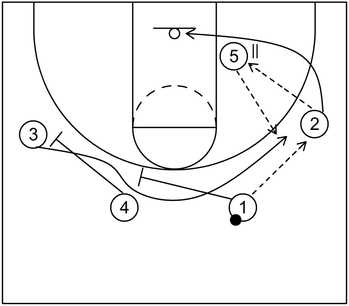
This is an example of scoring options after a low post player receives the ball during the secondary break. To begin, 2 receives the ball from 1 and then, 5 receives the ball from 2.
Next, 2 executes a Laker cut to the basket and could receive the ball from 5 as a possible scoring opportunity. Also, as that happens, 3 could cut to the vacant right side wing via screens set away from the ball by 1 and 4.
After that, 3 could receive the ball from 5 as another potential scoring option and then take the jump shot if open.
Moreover, if those options are not available, then 5 could simply score near the basket with a low post move.
What is an example of pick and roll scoring options within the secondary break
Part 1

This is an example of pick and roll scoring options within the secondary break. To start, 2 receives the ball from 1 and then, 1 cuts to the basket via the UCLA screen set by 5.
After that, 1 could receive the ball from 2 and score at the rim if that is open. Otherwise, 1 could cut through to the left side corner.
Part 2
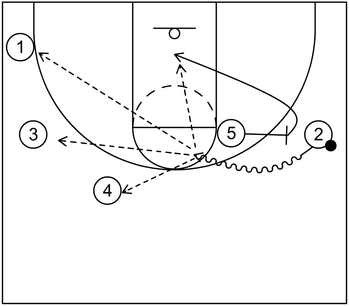
Next, 2 could dribble towards the high post area via a on-ball screen set by 5. Following that action, 5 rolls to the basket and could receive the ball from 2 if that is open.
Alternatively, 2 could take the mid-range jump shot if that is open or one of the other teammates behind the three-point line could receive the ball from 2 for additional possible jump shot opportunities.
What is an example of pick and pop scoring options within the secondary break
Part 1
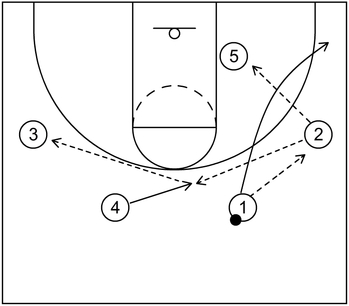
This is an example of pick and pop scoring options within the secondary break. To begin, 2 receives the ball from 1 and then, 1 cuts to the right side corner, similar to the triangle offense formation.
After that, 5 could receive the ball from 2 and score quickly with a low post move near the basket. Alternatively, if 5 is not open to receive the ball, then 4 could cut to the top and receive it from 2.
From there, 3 could receive the ball from 4 to complete the ball reversal action.
Part 2
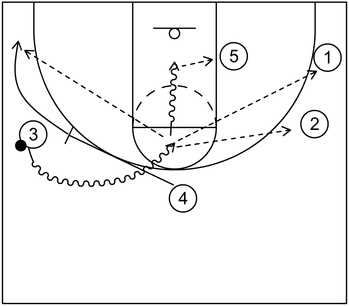
Next, 3 could dribble towards the high post area via the on-ball screen set by 4. Immediately after setting the screen, 4 could pop to the left side corner.
At that point, 3 could take the mid-range jump shot or drive to the basket and score at the rim.
Alternatively, 3 could pass the ball to the teammates behind the three-point line for possible jump shot opportunities as well. Moreover, 5 could receive the drop pass from 3 and score near the basket as another potential scoring option.
What are examples of high low scoring options within the secondary break
Example 1

This is an example of a high low scoring option within the secondary break. To start, 2 receives the ball from 1 and following that, 3 cuts to the high post area via the screen set by 4.
Next, 3 receives the ball from 2 and afterwards, 5 steps into the lane, receives the high low pass from 3, and scores near the basket.
Example 2 – Part 1
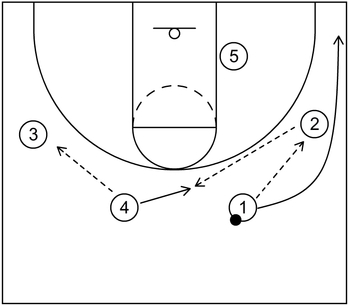
This is an example of high low scoring options derived from elements of The Blitz Secondary Break by Lindsay Gottlieb.
To start, 2 receives the ball from 1 and after that, 1 cuts to the right side corner by going under 2. As that occurs, 4 cuts to the top to receive the ball from 2 and then 3 receives the ball from 4 to finish the reversal action.
Example 2 – Part 2

Next, 5 cuts to the high post via a down screen set by 4 and receives the ball from 3. Immediately following the screening action, 4 could open up to receive the high low pass from 5 and score near the basket.
What is an example of a pass and screen away scoring option within the secondary break
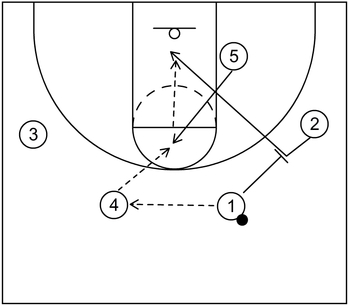
This is an example of a pass and screen away quick hitting scoring option within the secondary break.
To begin, 4 receives the ball from 1 and then, 5 flashes to the high post area to receive the ball from 4. Next, 1 cuts away from the ball to set a screen for 2.
However, 2 rejects that screen and immediately executes a backdoor cut to the basket. From there, 2 could receive the ball from 5 and score at the rim with a layup.
What is an example of a three-point scoring play within the secondary break
Part 1
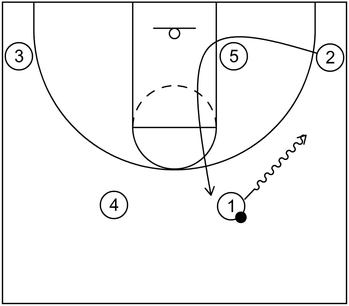
This is an example of a quick hitting scoring play which could be used to create a three-point opportunity for the team’s best shooter derived from elements of Transition Drills and Early Offense by Johnny Jones.
To start, 1 executes a dribble entry towards the right side wing which also triggers a zipper cut to the vacated right slot area by 2.
Furthermore, as a side note, this dribble entry and zipper cut is sometimes referred to as a loop action as well.
Part 2
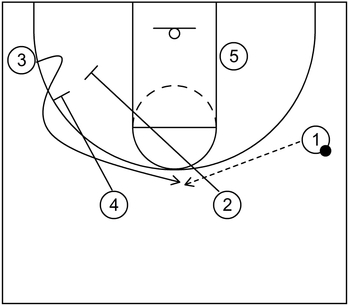
Next, 3 cuts to the top by way of stagger screen action by 2 and 4. Following that, 3 could receive the ball from 1 and take the open three-point shot.